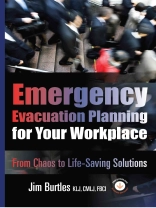Would your routine office fire drill be able to handle the large-scale chaos of a major disaster? Can you get everyone out safely in the face of a factory fire, explosion, or natural disaster? In Emergency Evacuation Planning for Your Workplace: From Chaos to Life-Saving Solutions, Jim Burtles leads you step-by-step through a planning methodology that saves lives. You can be assured your company will be ready and that everyone will know what to do — whatever the nature of the emergency.
In one practical, easy-to-read resource, Burtles helps you create a comprehensive plan to evacuate people of all ages and health conditions from workplaces such as small offices, skyscrapers, stores, industrial plants, hospitals, college campuses, and more. His carefully constructed methodology leads you through the development of organization-wide plans – ensuring that your procedures align with best practices, relevant regulations, sound governance, and corporate responsibility.
His five stages of an Emergency Evacuation Planning (EEP) Lifecycle include:
Thought-provoking discussion questions, real-life case studies and examples, comprehensive index, and detailed glossary facilitate both college and professional instruction.
Downloadable resources and tools – practical toolkit full of innovative and field-tested plans, forms, checklists, tips, and tools to support you as you set up effective workplace evacuation procedures.
Instructor’s Manual available for use by approved adopters in college courses and professional development training.
สารบัญ
Preface Foreword by Melvyn Musson, FBCI, CDRP Foreword by Steve Dance, CISA Foreword by Vali Hawkins Mitchell, Ph.D., LMHC Introduction: The Essentials of Emergency Evacuation Planning 0.1 Are You Prepared? 0.2 Summary of How the Emergency Evacuation Planning Lifecycle Works 0.3 EEP Is an Ongoing Process Discussion Questions PHASE 1: – Set Up the Emergency Evacuation Planning Program 1.1 A Formal Methodology 1.1.1 The Lifecycle Model 1.2 Program Management 1.3 Policy Development and Management Approval 1.4 Management Approval 1.5 Making the Business Case 1.6 Managing EEP 1.7 Evacuation Triggers 1.8 Coordination with Business Continuity Management 1.9 Obligations and Responsibilities Key Actions Discussion Questions PHASE 2 – Embed EEP Into an Aware and Prepared Corporate Culture 2.1 BCI Good Practice Guidelines 2.2 Developing the Training Program 2.3 Presenting the Training 2.4 Publicizing Within the Company 2.5 Aligning With Business Continuity Key Actions Discussion Questions PHASE 3 – Developing an Understanding of the Environment 3.1 Data Collection Parameters 3.2 Physical Risk Assessment (PRA) 3.3 Emergency Impact Analysis (EIA) 3.4 Escape Requirements Analysis Key Actions Discussion Questions PHASE 4 – Determining Evacuation Strategy 4.1 Gathering a Dimension of Environmental Data and Analyzing Necessary Information 4.2 Concerns for the Disabled 4.3 Planning for the Disabled 4.4 Personal Emergency Egress or Escape Plans (PEEPs) 4.5 High-Rise Buildings 4.6 Signs and Signage Key Actions Discussion Questions PHASE 5 – Developing Plans and Procedures 5.1 Evacuation and Assembly 5.2 Making Sure Everybody is Safe 5.3 Evacuation Plan Content 5.4 Types of Premises 5.5 Helping People Afterwards Key Actions Discussion Questions PHASE 6 – The Ongoing Program: Exercise and Maintain the EEP 6.1 Peer Group Review 6.2 Test and Exercise Defined 6.3 A Delivery and Service Regime 6.4 Conducting Tests and Exercises 6.5 Review and Update 6.6 ‘Smart’ Fire Drills Key Actions Discussion Questions Epilogue Appendix A Appendix B Glossary Index About the Author How to Get Your Free Download
เกี่ยวกับผู้แต่ง
Jim Burtles KLJ, MMLJ, Hon FBCI is a well-known and respected leader within the business continuity profession. Now semi-retired and living in West London, he can look back and reflect upon the lessons learned from a wealth of experience gained in some 40 years of practice, spread across 4 continents and 24 countries. He was granted Freedom of the City of London in 1992, received a Lifetime Achievement Award in 2001, and was awarded an Honorary Fellowship by the Business Continuity Institute (BCI) in 2010. In 2005, he was granted the rank of a Knight of Grace in the Military and Hospitaller Order of St. Lazarus of Jerusalem, an ancient and charitable order which cares for those afflicted with leprosy and similar debilitating diseases.Working as an IBM field engineer, in the mid-70s he took on the role of a rescue engineer, helping customers recover their damaged systems in the wake of fires, floods, and bombings. This type of work was the beginning of what later became known as disaster recovery. During the 80s, he became an early pioneer of what was then the emerging business continuity profession. In 1994 he helped to found the Business Continuity Institute (BCI) and now serves on its Global Membership Council, representing the interests of the worldwide membership. His practical experience includes hands-on recovery work with victims of traumatic events such as explosions, earthquakes, storms, and fires. This includes technical assistance and support in 90-odd disasters, as well as advice and guidance for clients in over 200 emergency situations.Over the past 40 years, Jim Burtles has introduced more than 3, 500 people into the business continuity profession through formal training programs and has provided specialist training for another 800 or so through workshops covering specific subjects or skill areas. For several years he was a regular visiting lecturer at Coventry University.Recent published works include Coping with a Crisis: A Counselor’s Guide to the Restabilization Process, 2011, and Emergency Evacuation Planning for Your Workplace: From Chaos to Life-Saving Solutions, published by Rothstein Publishing in August 2013.












